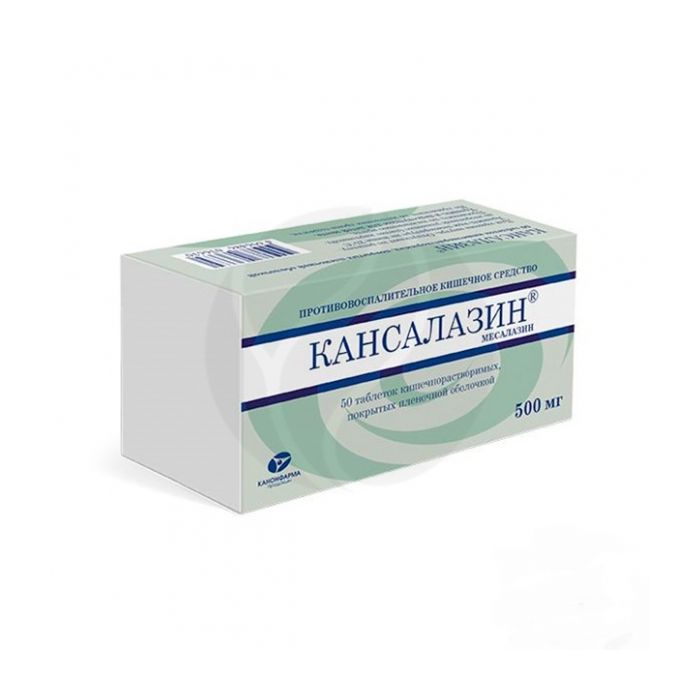Kansalazin tablets of prolonged action, p / o 500mg, No. 50
Expiration Date: 05/2027
Russian Pharmacy name:
Кансалазин таблетки пролонгированного действия п/о 500мг, №50
NNC,
Crohn's disease (prevention and treatment of exacerbations).
The method of application and dosage regimen of a particular drug depends on its form of release and other factors. The optimal dosage regimen is determined by the doctor. It is necessary to strictly observe the compliance of the used dosage form of a particular drug with the indications for use and the dosage regimen.
Inside, 400-800 mg are used 3 times / day for 8-12 weeks.
Enteric tablets, film-coated yellow, oval, biconvex; in cross section - from almost white with a grayish tint to light brown interspersed.
1 tab.
Active ingredient: mesalazine - 500 mg
Excipients: glycine - 10 mg, hypromellose (hydroxypropyl methylcellulose) - 2 mg, colloidal silicon dioxide - 5 mg, croscarmellose sodium - 10 mg, magnesium stearate - 5 mg, sodium carbonate anhydrous - 80 mg, povidone K30 - 20 mg, microcrystalline cellulose - 83 mg.
The composition of the film shell: Acryl-Iz yellow (93ќ220009) - 93.818 mg, including: copolymer of methacrylic acid and ethyl acrylate [1: 1] - 37.5272 mg, iron dye yellow oxide - 2.8182 mg, colloidal silicon dioxide - 1.1712 mg, sodium bicarbonate - 1.1224 mg, sodium lauryl sulfate - 0.4758 mg, talc - 34.953 mg, titanium dioxide - 11.2606 mg, triethyl citrate - 4.5018 mg, copolymer of methacrylic acid and ethyl acrylate [1: 1] (Collicut MAE100P) - 28.182 mg.
Blood diseases
severe liver and / or kidney dysfunction,
peptic ulcer of the stomach or duodenum in the acute phase,
blood clotting disorders,
children under 2 years old,
hypersensitivity to salicylates.
Clinical and pharmacological group: An anti-inflammatory drug used to treat Crohn's disease and NUC
Pharmaco-therapeutic group: Anti-inflammatory intestinal agent
pharmachologic effect
Anti-inflammatory agent with a predominant localization of action in the intestine. Mesalazine (5-aminosalicylic acid) inhibits the activity of neutrophil lipoxygenase and the synthesis of arachidonic acid metabolites (prostaglandins and leukotrienes), which are inflammatory mediators. Inhibits migration, degranulation, phagocytosis of neutrophils, as well as the secretion of immunoglobulins by lymphocytes. Mesalazine has antioxidant properties by binding to free oxygen radicals.
Pharmacokinetics
After oral administration, mesalazine is slowly released from the dosage form in the distal small intestine and in the large intestine. Plasma protein binding is 43%. It is metabolized in the intestinal mucosa and in the liver to form N-acetyl-5-ASA. T1 / 2 is 0.5-2 hours. Mesalazine is excreted in the urine, mainly in the acetylated form.
Indications
NNC,
Crohn's disease (prevention and treatment of exacerbations).
Dosage regimen
The method of application and dosage regimen of a particular drug depends on its form of release and other factors. The optimal dosage regimen is determined by the doctor. It is necessary to strictly observe the compliance of the used dosage form of a particular drug with the indications for use and the dosage regimen.
Inside, 400-800 mg are used 3 times / day for 8-12 weeks.
Side effect
From the digestive system: diarrhea, nausea, vomiting, heartburn, abdominal pain, loss of appetite, dry mouth, stomatitis, increased activity of liver enzymes.
From the nervous system: headache, depression, dizziness, sleep disturbances, paresthesias, tremors, tinnitus.
Allergic reactions: skin rash, itching, erythema.
From the side of the cardiovascular system: palpitations, tachycardia, arterial hypertension or hypotension, chest pain, shortness of breath.
From the urinary system: proteinuria, hematuria, crystalluria, oliguria, anuria.
From the hematopoietic system: anemia, leukopenia, agranulocytosis, thrombocytopenia; hypoprothrombinemia.
Others: alopecia, a decrease in the production of lacrimal fluid.
Contraindications for use
Blood diseases
severe liver and / or kidney dysfunction,
peptic ulcer of the stomach or duodenum in the acute phase,
blood clotting disorders,
children under 2 years old,
hypersensitivity to salicylates.
Application during pregnancy and lactation
In the first trimester of pregnancy, use is possible only on strict indications. If the individual course of the disease allows, then in the last 2-4 weeks of pregnancy, mesalazine should be discontinued.
If necessary, use during lactation should decide on the termination of breastfeeding, due to the lack of sufficient clinical experience with the use of mesalazine in this category of patients.
Application for violations of liver function
Contraindicated in severe liver dysfunction.
Use with caution in liver diseases.
Application for impaired renal function
Contraindicated in severe renal impairment.
Use with caution in kidney disease.
Application in children
Contraindicated in children under 2 years of age.
Use in children under 2 years of age is possible only if the intended benefit of therapy outweighs the potential risk to the child.
special instructions
Use with caution in diseases of the liver and kidneys, deficiency of glucose-6-phosphate dehydrogenase, allergic diseases and predisposition to them. Before starting treatment, and then monthly during the first 3 months of treatment, monitoring of the picture of peripheral blood, liver function, as well as determination of the concentration of urea and creatinine in the blood should be carried out. Patients who are 'slow acetylators' are at increased risk of side effects.
Use in children under 2 years of age is possible only if the intended benefit of therapy outweighs the potential risk to the child.
Drug interactions
With the simultaneous use of mesalazine with azathioprine, mercaptopurine, the toxicity of azathioprine and mercaptopurine increases; with warfarin - a case of decreasing the effectiveness of warfarin has been described.

